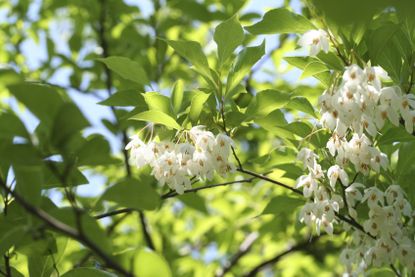Japanese Snowbell Growing: Tips On Japanese Snowbell Tree Care


Japanese snowbell trees are easy-to-care-for, compact, spring-blooming trees. Due to all of these things, they are perfect for moderately sized, low-maintenance beautifying in places such as parking lot islands and along property borders. Keep reading to learn more Japanese snowbell information, such as planting Japanese snowbell trees and subsequent Japanese snowbell care.
Japanese Snowbell Information
Japanese snowbell trees (Styrax japonicus) are native to China, Japan, and Korea. They are hardy in USDA zones 5 through 8a. They grow slowly to a height of 20 to 30 feet (6-9 m.), with a spread of 15 to 25 feet (5-8 m.). In late spring or early summer, usually in May and June, they produce mildly fragrant, white flowers. The flowers appear in clusters of small, five-petaled bells that show up very clearly as they hang down below the upward-growing foliage. The flowers are replaced in summer by green, olive-like fruits that are long-lasting and pleasant. Japanese snowbell trees are deciduous, but they’re not especially showy in the fall. In autumn, the leaves turn yellow (or occasionally red) and drop. Their most impressive season is spring.
Japanese Snowbell Care
Caring for a Japanese snowbell tree is very easy. The plant prefers partial shade in the warmer zones of its hardy climate (7 and 8), but in cooler areas, it can handle full sun. It does best in somewhat acidic, peaty soil. The ground should be kept moist with frequent watering, but not allowed to get soggy. Only some varieties are hardy down to zone 5, and they should be planted in a spot that’s sheltered from the winter winds. Over time, the tree will grow up into an attractive spreading pattern. No real pruning is required, though you will probably want to remove the lowest branches as it matures to make way for pedestrian traffic or, even better, a bench underneath it.
Gardening tips, videos, info and more delivered right to your inbox!
Sign up for the Gardening Know How newsletter today and receive a free download of our most popular eBook "How to Grow Delicious Tomatoes."

The only child of a horticulturist and an English teacher, Liz Baessler was destined to become a gardening editor. She has been with Gardening Know how since 2015, and a Senior Editor since 2020. She holds a BA in English from Brandeis University and an MA in English from the University of Geneva, Switzerland. After years of gardening in containers and community garden plots, she finally has a backyard of her own, which she is systematically filling with vegetables and flowers.
-
 Clever Vertical Vegetable Garden Ideas For Small Spaces – 7 Ways To Save Space
Clever Vertical Vegetable Garden Ideas For Small Spaces – 7 Ways To Save SpaceShort on garden space? Learn some vegetable garden ideas for small spaces that are fun and easy.
By Mary Ellen Ellis
-
 26 Different Types Of Orchids – With Pictures & Information
26 Different Types Of Orchids – With Pictures & InformationDiscover stunning orchid types to grow in your home and garden – from easy beginner varieties to rare and exotic species that are the preserve of experts.
By Melanie Griffiths